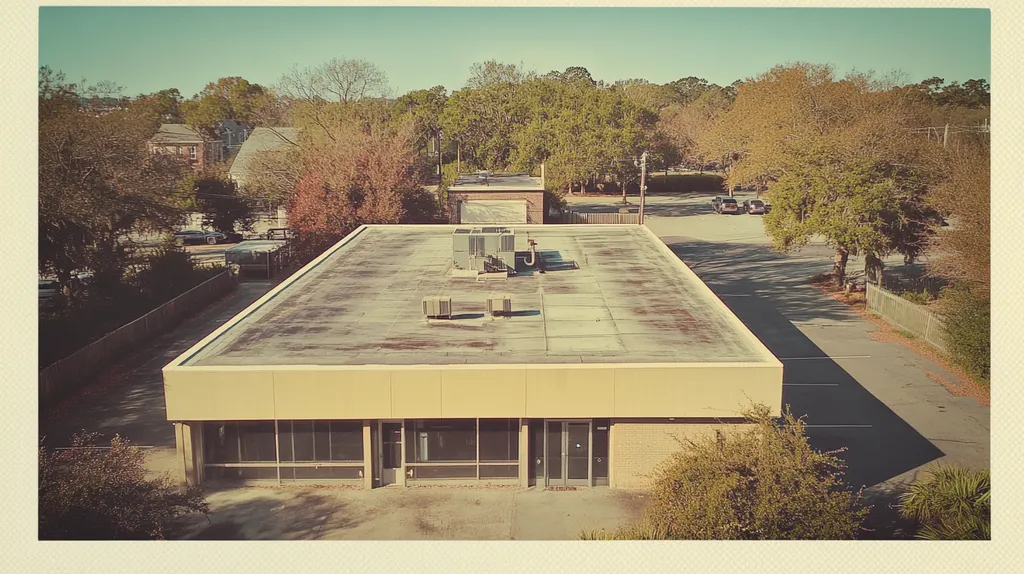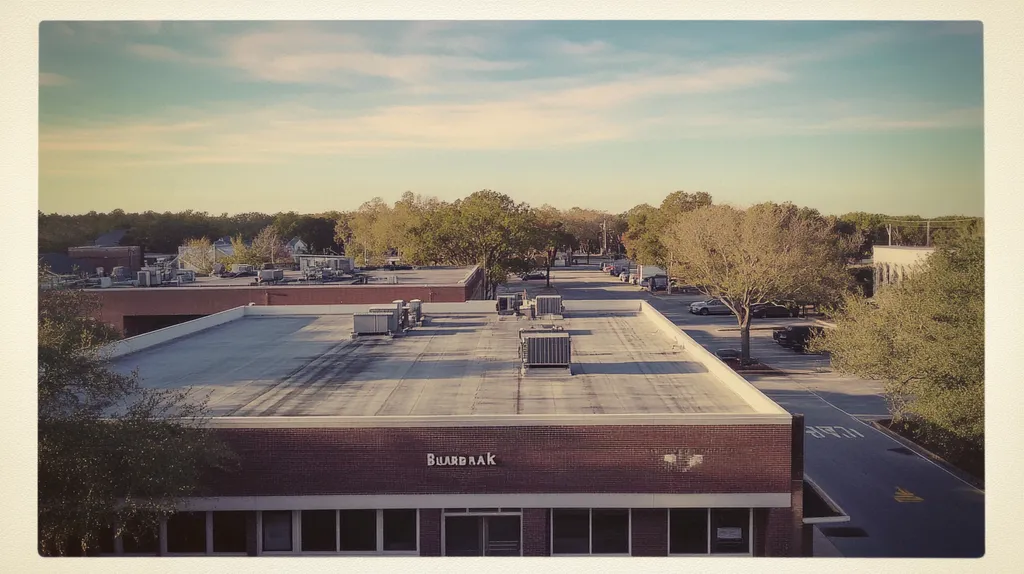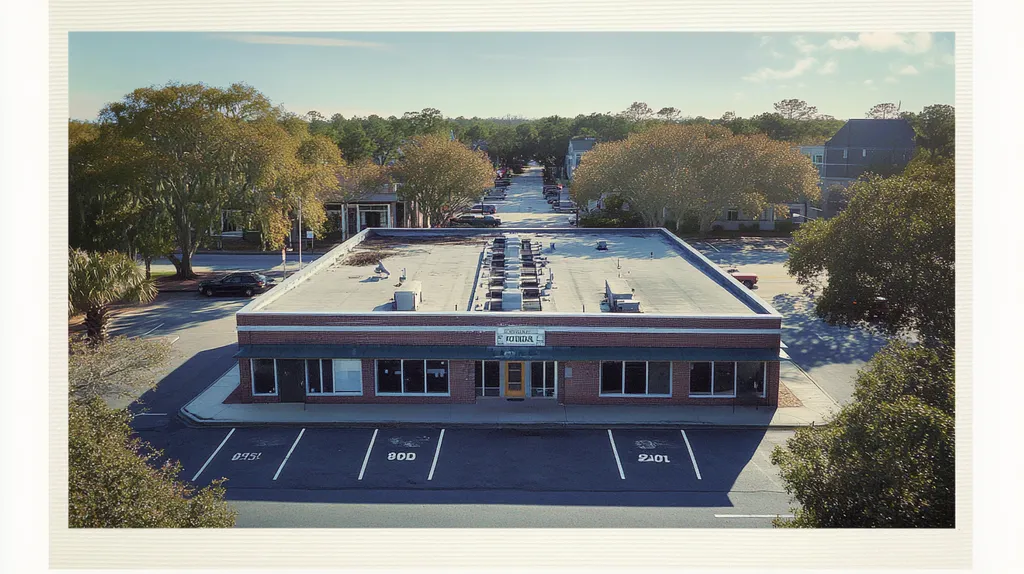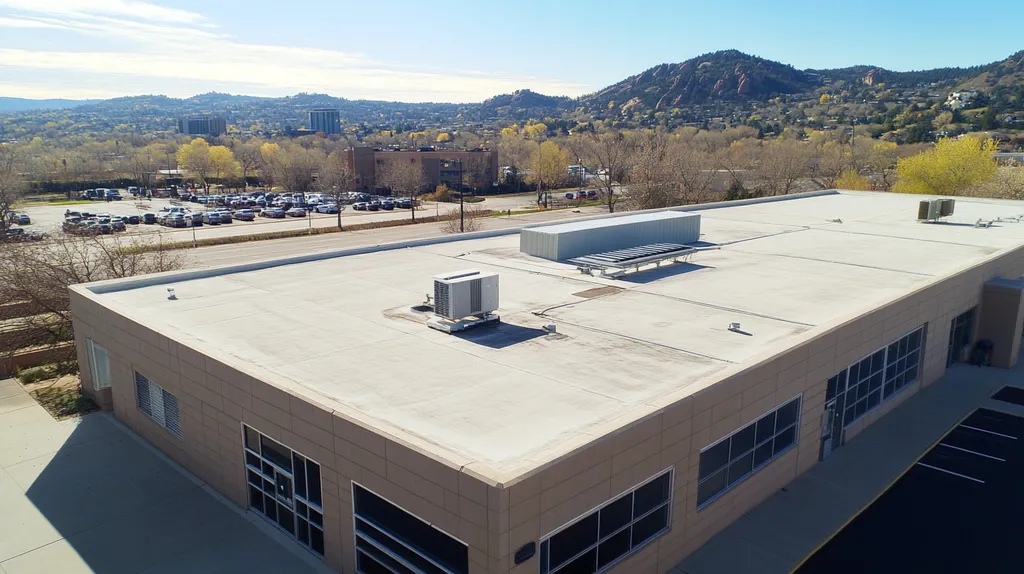Water damage from poor roof drainage costs U.S. businesses over $1.7 billion annually in repairs and lost productivity. Studies show that 90% of commercial roof failures stem from drainage issues, with repair costs often exceeding $500,000 for a typical facility.
For property owners and facility managers, understanding proper drainage isn’t just about maintenance – it’s about protecting critical assets and ensuring business continuity.
This comprehensive guide examines the fundamental concepts, components, and best practices that determine commercial roof longevity through effective drainage management.
SECTION 1: FUNDAMENTAL CONCEPTS
Water damage from poor drainage is the leading cause of premature commercial roof failure, with studies showing it can reduce a roof’s expected lifespan by up to 40%. For a typical 20,000-square-foot commercial roof, improper drainage can lead to repair costs exceeding $100,000 and potentially catastrophic structural damage. Understanding and implementing proper drainage solutions is not just about maintaining a building – it’s about protecting a significant capital investment and ensuring business continuity.
Principles of Roof Drainage and Water Flow
Roof drainage systems must handle both routine precipitation and extreme weather events effectively. High-quality roof drains, constructed to meet ANSI Standard A112.21.2M specifications, form the cornerstone of reliable water management systems. (source: Zurn)
The primary drainage system consists of internal drains, scuppers, and gutters working in concert. These components must be strategically placed to prevent water from traveling more than 40 feet before reaching a collection point.
Secondary (emergency) drainage systems serve as critical backup when primary systems become overwhelmed. These typically include overflow scuppers or a separate network of drains positioned slightly higher than the primary system.
Water flow patterns must be carefully calculated during the design phase. This includes accounting for roof deck deflection, which can create unexpected low spots where water accumulates.
Impact of Drainage on Roof Longevity
Every inch of standing water adds approximately 5.2 pounds of weight per square foot to the roof structure. This additional weight creates stress points that accelerate membrane deterioration and compromise structural integrity.
Proper drainage prevents ponding water, which can lead to membrane degradation, seam failures, and eventual leaks. Even minor ponding can create conditions for algae growth, which further degrades roofing materials.
Temperature fluctuations cause ponded water to expand and contract, creating micro-movements that stress roofing materials. This cycle accelerates aging and can void manufacturer warranties.
Regular drainage system maintenance, including quarterly inspections and cleaning, can extend a roof’s serviceable life by 25-35% compared to neglected systems.
Influence of Climate and Roof Slope on Drainage
Local climate conditions directly impact drainage system requirements. Regions with heavy rainfall need larger drain diameters and more frequent collection points, while areas with significant snowfall require special considerations for meltwater management.
Roof slope, measured in units of vertical rise per horizontal run, determines water flow velocity. A minimum slope of 1/4 inch per foot is recommended for positive drainage, though some regions require steeper slopes based on local building codes.
Wind patterns affect drainage performance by potentially forcing water to flow against the intended drainage path. This requires strategic placement of drainage components and sometimes wind barriers.
Thermal cycling between seasons can cause roof materials to expand and contract, potentially altering drainage paths. Regular inspections should account for these seasonal changes to maintain optimal drainage performance.
SECTION 2: SYSTEM COMPONENTS
Every commercial roof represents a significant investment that depends on properly functioning drainage components. A single drain failure can lead to catastrophic damage, with repair costs often exceeding $50,000 for a typical commercial building. Understanding these critical systems isn’t just about maintenance – it’s about protecting your facility’s structural integrity and avoiding business interruptions that can cost thousands per day in lost productivity.
Key Drainage Components: Drains, Gutters, and Scuppers
Internal roof drains serve as the primary water collection points, strategically positioned to prevent water accumulation. These must be installed at the lowest points of the roof to ensure proper water flow and prevent ponding.
Gutters function as the roof’s first line of defense, channeling water away from edges and protecting the building’s facade. Proper sizing and slope are crucial – undersized gutters can overflow during heavy rains, leading to foundation damage.
Scuppers provide essential overflow protection, acting as safety valves when primary drainage systems become overwhelmed. These through-wall openings must be sized appropriately for the roof area they serve.
The placement and quantity of these components directly impact drainage efficiency. Each drain typically serves between 5,000-10,000 square feet of roof area, depending on local rainfall intensity and building codes.
Strainers, Filters, and Drain Basket Functionality
Dome strainers prevent debris infiltration while maintaining optimal water flow into the drainage system. Building codes mandate these protective covers, with a minimum height requirement of 4 inches to ensure proper functionality.
Specialized flashing clamps create watertight seals around drain assemblies, protecting the roofing membrane from water intrusion at these critical junctures. These components work together with air baffles in siphonic systems to enhance drainage efficiency. (source: IKO.com)
Regular inspection and cleaning of strainers prevent debris accumulation that can lead to blocked drainage. Even partial blockages can reduce drain capacity by 50% or more.
Filter maintenance schedules should align with local foliage patterns and weather conditions. Areas with heavy tree coverage require more frequent cleaning intervals.
Structural Elements: Crickets, Sump Pans, and Flashing
Crickets direct water flow away from roof projections and toward drainage points. These raised triangular structures prevent water from pooling behind HVAC units, skylights, and other rooftop equipment.
Sump pans create subtle depressions around drain locations, ensuring positive water flow toward collection points. Proper installation requires careful coordination between roofing and mechanical trades.
Metal flashing protects transition points where different roofing materials meet. These components must be properly overlapped and sealed to prevent water infiltration at vulnerable joints.
Regular inspection of these structural elements is essential, as their failure can lead to hidden water damage. Thermal movement and weather exposure can compromise seals and connections over time.
SECTION 3: IMPLEMENTATION METHODS
Effective drainage implementation can mean the difference between a roof lasting its full 20-30 year lifespan or failing prematurely within 5-10 years. On a typical 50,000-square-foot commercial roof, improper drainage implementation can lead to repair costs exceeding $250,000 and potentially catastrophic structural failure. This section examines the critical aspects of drainage system design, installation techniques, and material selection that determine long-term performance.
Designing Effective Slope and Drainage Layouts
Conventional roof drainage systems rely on gravity and proper slope to direct water flow effectively. Minimum slope requirements of ¼ inch per foot ensure water moves consistently toward collection points, preventing pooling and structural stress.
Strategic drain placement requires careful calculation of drainage zones. Each roof area should have primary and backup drainage points, with water travel distance limited to 40 feet between collection points.
Tapered insulation systems can create artificial slope on flat roof structures. These systems must account for deck deflection and equipment locations to prevent unexpected low spots.
Advanced siphonic drainage systems can move water at speeds up to 7 m/s, compared to conventional gravity systems at 2 m/s, offering superior performance for large roof areas. (source: Allianz Commercial)
Installation Techniques for Internal and Edge Drains
Proper installation begins with precise drain placement at calculated low points. Sump areas must be carefully constructed to ensure positive drainage without creating stress points in the roofing membrane.
Drain flashing requires special attention during installation. A minimum three-foot square area around each drain must be properly waterproofed to prevent seepage at these critical junctions.
Edge drain systems need careful integration with the building’s vertical surfaces. Proper counterflashing height and overlap prevent water infiltration during heavy rainfall or wind-driven rain events.
Regular inspection points must be incorporated into the installation design. Access panels and cleanouts should be positioned for easy maintenance without compromising system integrity.
Selection Criteria for Drainage Materials and Systems
Material selection must account for both immediate performance needs and long-term durability. UV-resistant materials prevent premature degradation, while corrosion-resistant metals ensure sustained performance in aggressive environments.
System capacity calculations must factor in local rainfall intensity data. Drainage components should be sized to handle 100-year storm events while maintaining significant safety margins.
Component compatibility is crucial for system longevity. All materials must work together without chemical interaction or thermal movement issues that could compromise connections.
Future maintenance requirements should influence material choices. Selecting materials that resist debris accumulation and facilitate easy cleaning can significantly reduce long-term maintenance costs.
SECTION 4: MAINTENANCE REQUIREMENTS
Regular maintenance of commercial roof drainage systems directly impacts both operational costs and structural integrity. Studies show that up to 90% of roof failures stem from poor maintenance practices, with drainage issues being the primary culprit. For a typical 50,000-square-foot commercial roof, implementing a proper maintenance program costs approximately $15,000 annually – compared to potential repair costs exceeding $500,000 when drainage systems fail catastrophically.
Routine Inspection and Cleaning of Drainage Elements
Commercial roof drainage systems require comprehensive inspections at least quarterly, with additional checks after severe weather events. These inspections must evaluate all drainage components, including internal drains, scuppers, and downspouts for signs of deterioration or blockage.
Professional cleaning should remove accumulated debris while documenting any developing issues. Digital documentation with photos helps track changes over time and supports maintenance planning.
Trouble-free operation requires particular attention to overflow channels and emergency drains, which must be properly sized and maintained to handle peak rainfall events. (source: Allianz Risk Consultants)
Maintenance teams should verify proper drain strainer installation and condition during each inspection. Damaged or missing strainers can allow large debris to enter and block drainage pipes.
Managing Debris and Preventing Drain Clogging
Effective debris management starts with identifying and controlling external sources. This includes trimming overhanging branches, installing leaf guards on gutters, and maintaining clean roof surfaces.
Strategic placement of drain protection systems helps prevent debris accumulation while maintaining optimal water flow. These systems should be selected based on local environmental conditions and typical debris types.
Regular removal of surface debris prevents material from breaking down and clogging drainage components. This is especially critical during fall months when leaf accumulation peaks.
Maintenance crews should document common debris types and accumulation patterns to optimize cleaning schedules and prevention strategies.
Repair Protocols for Drainage Components and Flashing
Establish clear repair protocols that prioritize drainage system integrity. This includes maintaining detailed repair histories and implementing preventive maintenance schedules based on component age and condition.
Address minor repairs immediately to prevent escalation into major system failures. Even small gaps in flashing or minor membrane separations around drains can lead to significant water damage.
Verify that repair materials match existing system components in both material composition and performance characteristics. Incompatible materials can create new failure points.
Document all repairs with photographs and detailed notes, creating a comprehensive maintenance history that supports future planning and budgeting decisions.
SECTION 5: PERFORMANCE METRICS
For commercial property owners, effective drainage metrics directly impact both maintenance costs and roof longevity. Industry data shows that poorly monitored drainage systems reduce roof lifespan by up to 70% and can lead to catastrophic failures costing upwards of $300,000 for a typical 50,000-square-foot facility. Understanding and tracking key performance indicators allows facility managers to prevent minor drainage issues from escalating into major structural problems.
Indicators of Proper Drainage Functionality
Visual inspections should confirm water movement toward collection points within 30 minutes after rainfall. Any standing water beyond this window indicates potential drainage issues requiring immediate attention.
Flow rate measurements at drain points help verify system capacity. Standard commercial drains should process 100 gallons per minute at full capacity, with reduced performance signaling potential blockages or design inadequacies.
Pressure testing of drainage lines identifies restrictions or damage that may not be visible from the roof surface. Annual testing helps prevent sudden system failures during critical weather events.
Documentation through digital mapping creates historical performance records that highlight developing problems before they become critical. This data drives proactive maintenance scheduling and budget planning.
Assessing Roof Ponding and Water Flow Efficiency
Siphonic drainage systems can achieve water velocities up to 7 m/s, compared to conventional gravity systems at 2 m/s, providing superior performance for large commercial roofs. These enhanced flow rates significantly reduce ponding risks and structural stress. (source: Allianz Commercial)
Water depth measurements at key collection points should never exceed 1 inch during normal rainfall. Greater depths indicate potential drain restrictions or inadequate system capacity.
Flow pattern analysis using dye testing reveals unexpected water movement that may contribute to ponding. This helps identify areas where slope corrections or additional drainage may be needed.
Regular monitoring of drainage zones ensures water travel distances remain within the 40-foot maximum recommended distance to collection points. Exceeding this distance increases ponding risks.
Monitoring Material Degradation and Drainage Wear
Monthly inspections of membrane seams and flashing around drainage components help identify early signs of material failure. Documentation should track any separation, cracking, or deterioration that could compromise water flow.
Infrared moisture mapping conducted semi-annually reveals subsurface water accumulation that may indicate drainage system failures. Early detection prevents extensive membrane damage and costly repairs.
Drain component wear assessment focuses on strainer condition, membrane attachment, and clamping ring integrity. These critical elements require replacement when showing signs of corrosion or damage.
Performance tracking should include photographic documentation of wear patterns and material aging. This creates a comprehensive record for planning systematic component upgrades before failures occur.
SECTION 6: OPTIMIZATION STRATEGIES
Optimizing commercial roof drainage systems represents a critical investment decision that directly impacts building longevity and operational costs. Studies show that inadequate drainage optimization leads to repair costs averaging $12-15 per square foot – meaning a typical 50,000-square-foot commercial roof could face $750,000 in preventable damage. Beyond immediate repair costs, water damage from poor drainage optimization causes business disruptions averaging 3-5 days per incident, resulting in significant revenue loss.
Upgrading Drainage Systems for Enhanced Longevity
Strategic drainage upgrades can extend roof lifespan by 40-50% while reducing annual maintenance costs by up to 60%. These improvements focus on increasing water removal capacity and preventing ponding through enhanced system design.
Modern drainage upgrades incorporate smart monitoring systems that detect blockages and flow restrictions before they cause damage. These systems can identify potential issues weeks before they would be visible during routine inspections.
High-capacity drain assemblies with improved sump designs can increase water removal rates by 300% compared to traditional systems. This enhanced performance prevents membrane damage from prolonged water exposure.
Integration of tapered insulation systems during upgrades creates positive drainage paths that eliminate ponding water. This approach addresses both drainage efficiency and thermal performance simultaneously.
Integrating Siphonic Drainage for Large Roof Areas
Siphonic drainage systems achieve water velocities up to 7 m/s through vacuum principles, compared to conventional gravity systems operating at just 2 m/s. This dramatic performance improvement enables more efficient water removal while requiring fewer roof penetrations. (source: Allianz Risk Consulting)
The reduced pipe diameter requirements of siphonic systems translate to 40% less installation cost compared to traditional gravity drainage. These savings help offset the initial investment in advanced drainage technology.
Horizontal pipe routing capabilities eliminate the need for pitched drainage lines, maximizing usable space below the roof structure. This feature proves particularly valuable in facilities with limited plenum space.
Self-cleaning velocities inherent to siphonic systems reduce maintenance requirements and prevent debris accumulation. This characteristic is especially beneficial in areas with heavy foliage or industrial particulate exposure.
Best Practices for Reducing Roof Water-Related Damage
Implementation of preventive maintenance protocols can reduce water-related repair costs by up to 75% over the roof’s lifespan. These protocols should include quarterly inspections and immediate response to drainage issues.
Strategic placement of moisture detection systems enables early intervention before water infiltration causes structural damage. These systems can detect moisture presence within roofing assemblies months before visible signs appear.
Installation of overflow warning systems with remote monitoring capabilities ensures rapid response to drainage system failures. This technology proves particularly valuable during off-hours when facility staff isn’t present.
Development of comprehensive drainage maintenance schedules based on local climate data and historical performance metrics maximizes system efficiency. These schedules should account for seasonal variations in precipitation patterns and debris accumulation.
The Bottom Line
The $1.7 billion annual cost of water damage to commercial roofs underscores the critical importance of proper drainage system design, implementation, and maintenance.
Research demonstrates that 90% of premature roof failures stem from drainage issues that could have been prevented through systematic monitoring and maintenance.
For facility managers and property owners, implementing comprehensive drainage strategies represents the difference between a roof reaching its full 30-year lifespan or failing within a decade.
The proven correlation between drainage performance and roof longevity makes clear that investing in drainage optimization isn’t merely a maintenance concern – it’s a critical business decision that directly impacts both operational continuity and long-term profitability.
FREQUENTLY ASKED QUESTIONS
Q. What causes premature failure in a commercial roof?
A. Water damage from poor drainage is the leading cause of premature roof failure. Proper drainage is crucial to avoid costly repairs and structural damage, prolonging your roof’s lifespan.
Q. What are key components of a commercial roof drainage system?
A. Key components include internal drains, gutters, and scuppers, which work together to manage water flow. Proper installation and maintenance of these elements are essential for effective drainage performance.
Q. How can I ensure proper slope for a commercial roof?
A. Ensure a minimum slope of ¼ inch per foot to direct water effectively. Use tapered insulation systems if necessary, and calculate drain placement to limit water travel distance.
Q. What maintenance is required for a commercial roof drainage system?
A. Perform quarterly inspections and cleanings to ensure all drainage components are functioning. This includes checking for blockages, evaluating strainers, and maintaining overflow systems to prevent failures.
Q. How can I measure drainage system performance?
A. Conduct visual inspections, monitor flow rates, and check for standing water after rainfall. Documentation of these metrics will help track system performance and anticipate maintenance needs.
Q. What are best practices for optimizing commercial roof drainage?
A. Upgrade drainage systems with high-capacity designs and implement smart monitoring technologies. Regular maintenance based on local weather patterns can further enhance system efficiency and longevity.
Q. How does climate affect commercial roof drainage requirements?
A. Local climate influences the size and spacing of drainage components. Areas with heavy rainfall demand larger drains, while snowy regions need special designs for managing meltwater efficiently.










